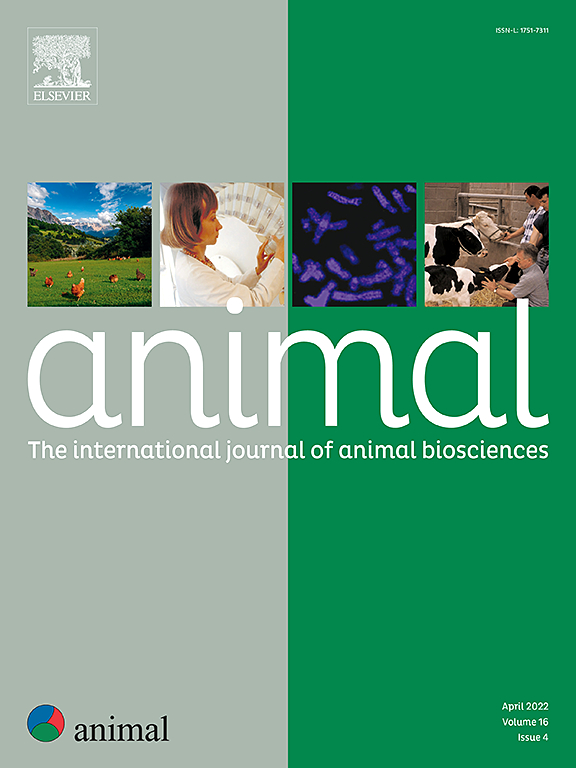Influence of forage-to-concentrate ratio on the effects of a radiata pine bark extract on methane production and fermentation using the rumen simulation technique
IF 4
2区 农林科学
Q1 AGRICULTURE, DAIRY & ANIMAL SCIENCE
引用次数: 0
Abstract
Climate change and food safety standards have intensified research into plant-based compounds as alternatives to dietary supplements in animal feed. These compounds can reduce enteric methane (CH4) emissions and the formation of ruminal ammonia. This study investigated the effects of radiata pine bark extract (PBE) supplementation on CH4 production, ruminal fermentation parameters, and nutrient disappearance using the rumen simulation technique in diets with different forage-to-concentrate (F:C) ratios. The experimental design was a 22 factorial arrangement of two F:C ratios [70:30 (HF) vs 30:70 (HC)], without or with PBE (2% on a DM basis). Two consecutive incubations were conducted during 15 days, with 10 days of adaptation, followed by 5 days of sampling. Use of PBE decreased ammonia nitrogen (NH3-N, P < 0.001) and total volatile fatty acids (VFAs, P = 0.019) concentrations, while it increased acetate (P < 0.001) and propionate (P < 0.001) proportions in both diets. However, CH4 yield [mg/g organic matter (OM) disappeared] tended to be reduced by 33.6% (P = 0.088) only in the HF diet supplemented with PBE. The OM disappearance tended to increase (P = 0.079) with PBE; hemicellulose disappearance increased in HF and decreased in HC diets (P < 0.001), whereas protein disappearance decreased in HF and increased in HC diets (P < 0.001). In conclusion, PBE supplementation reduced NH3-N and VFA concentrations in HF and HC diets, but CH4 yield (mg/g OM disappeared) was only reduced in the HF diet. Additionally, nutrient disappearance was dependent on the F:C ratio of the diet, without adverse effects on ruminal fermentation. Hence, the incorporation of radiata PBE into HF diets could serve as an environmentally friendly additive, potentially offering an alternative use for a forestry industry by-product, while beneficially modulating ruminal fermentation.
料精比对辐射松皮提取物产甲烷和瘤胃模拟发酵影响的影响
气候变化和食品安全标准加强了对植物性化合物作为动物饲料中膳食补充剂替代品的研究。这些化合物可以减少肠道甲烷(CH4)排放和瘤胃氨的形成。本试验采用模拟瘤胃技术,研究了在不同料精比(F:C)饲粮中添加辐射松皮提取物(PBE)对CH4产量、瘤胃发酵参数和营养物质消失的影响。实验设计为22因子排列,两种F:C比例[70:30 (HF) vs 30:70 (HC)],无PBE或有PBE (DM基础上2%)。在15天内连续孵育两次,其中10天适应,5天取样。仅在HF饲粮中添加PBE时,氨氮(NH3-N、p4产率[mg/g有机质(OM)消失]有降低33.6%的趋势(P = 0.088)。随着PBE的增加,OM消失有增加的趋势(P = 0.079);半纤维素消失率在HF组升高,在HC组降低(p3 - n和VFA浓度在HF和HC组均升高),但CH4产率(mg/g OM消失)仅在HF组降低。此外,营养物质的消失与饲粮的F:C比值有关,对瘤胃发酵无不良影响。因此,将辐射PBE添加到HF日粮中可以作为一种环保添加剂,在有益调节瘤胃发酵的同时,可能为林业副产品提供另一种用途。
本文章由计算机程序翻译,如有差异,请以英文原文为准。
求助全文
约1分钟内获得全文
求助全文
来源期刊

Animal
农林科学-奶制品与动物科学
CiteScore
7.50
自引率
2.80%
发文量
246
审稿时长
3 months
期刊介绍:
Editorial board
animal attracts the best research in animal biology and animal systems from across the spectrum of the agricultural, biomedical, and environmental sciences. It is the central element in an exciting collaboration between the British Society of Animal Science (BSAS), Institut National de la Recherche Agronomique (INRA) and the European Federation of Animal Science (EAAP) and represents a merging of three scientific journals: Animal Science; Animal Research; Reproduction, Nutrition, Development. animal publishes original cutting-edge research, ''hot'' topics and horizon-scanning reviews on animal-related aspects of the life sciences at the molecular, cellular, organ, whole animal and production system levels. The main subject areas include: breeding and genetics; nutrition; physiology and functional biology of systems; behaviour, health and welfare; farming systems, environmental impact and climate change; product quality, human health and well-being. Animal models and papers dealing with the integration of research between these topics and their impact on the environment and people are particularly welcome.
 求助内容:
求助内容: 应助结果提醒方式:
应助结果提醒方式:


